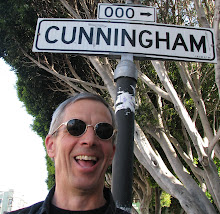 March 31 I was in Los Angeles to give a lecture on the opening night of my show at the Craft in America Study Center. Because I like to talk about quilts and play guitar at the same time, I concocted a lecture called Quilts and The Blues, which I thought would give me an opportunity for some amusing comparisons, but which, when I started writing the thing, made me realize all sorts of new aspects of these two forms.
March 31 I was in Los Angeles to give a lecture on the opening night of my show at the Craft in America Study Center. Because I like to talk about quilts and play guitar at the same time, I concocted a lecture called Quilts and The Blues, which I thought would give me an opportunity for some amusing comparisons, but which, when I started writing the thing, made me realize all sorts of new aspects of these two forms.For starters, we have to remember that both forms grew out of existing traditions. Quilts arrived here as formal bedcoverings for the houses of the well-to-do. Blues music has roots in African, folk and gospel musical traditions. Also, they both grew and flourished during the period when the creators of them were excluded from positions of power in the culture.
Women, being legally excluded from owning property or voting, and excluded from the academic traditions of the of the arts, excluded from politics and any positions of power in the culture, created quilts which they chose to give away. With this gift economy, they were safe from the judgements, the interference, the market considerations that would have prevailed if they were trying to appeal to or be part of the academy or the intellectual or the business worlds. Under this neglect by the powerful, women were free to create.
Blues musicians, being seen in the last part of the 19th century and the first part of the twentieth as similarly extra-academic, economically superflous, concerned only with amusing friends and family with their semi-musical plinking and plonking, were also free to create.
The forms these two groups invented were community-owned patterns. The 12-bar form, the 3 against 4 rhythmic feels, the borrowings from African drones and gospel harmonies and improvisations--all these were malleable and infinitely variable.
Within these community patterns, the creators were free to do anything they could think of...and, come to think of it, they didn't even have to stay within the patterns. Anything could work as a blanket if you sewed enough pieces together. You could write a blues with any number of beats, bars, chords or subjects.
So it was precisely because of the neglect of the ruling class that these forms could grow and flourish. To demonstrate the infinite variability of quilt patterns I put together a Powerpoint presentation with 20 or so variations of Log Cabin patterns. For the musical variations I played a variety of blues songs from different artists, all of whom had created wild variations on traditional themes.
It was a blast, for me at least. It seemed like it went over well, and the whole experience made me want to work more on my book of quilt essays.

No comments:
Post a Comment